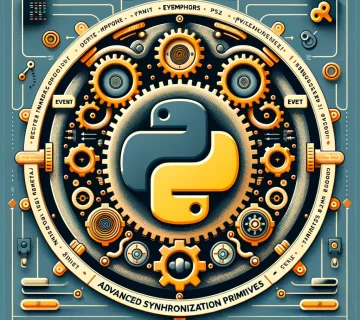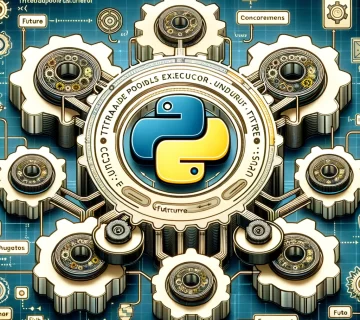In the realm of Python programming, mastering the art of concurrency is akin to unlocking a new level of performance and efficiency for your applications. Concurrency, the ability to run multiple operations simultaneously, is essential in building scalable and responsive software. Python, with its rich set of libraries and frameworks, offers robust support for concurrent execution through threading and multiprocessing. Understanding the nuances between these two models and learning when to employ each is crucial for Python developers looking to optimize their code for speed and performance.
This post embarks on an explorative journey through the complexities of concurrency in Python. We’ll delve into the critical differences between threading and multiprocessing, dissect the impact of the Global Interpreter Lock (GIL) on concurrent programming, and offer insights into choosing the right approach for various scenarios. Whether you’re dealing with I/O-bound tasks that benefit from the lightweight nature of threads or CPU-bound operations that demand the raw power of multiprocessing, this guide aims to equip you with the knowledge to make informed decisions. By navigating these concurrency models, you’ll not only enhance your Python applications but also open the door to a more profound understanding of parallel execution’s underlying principles.
Understanding Concurrency in Python
Definition of Concurrency and Its Significance in Modern Programming
Concurrency in programming refers to the ability of an application to make progress on multiple tasks or operations simultaneously. It is a concept closely associated with the efficient use of resources, particularly in applications that handle numerous tasks that don’t necessarily need to be executed sequentially. In the context of Python, concurrency involves techniques and mechanisms that allow your program to handle tasks like I/O operations, computations, and data processing in a way that optimizes performance and responsiveness.
The significance of concurrency has grown with the increasing complexity of software applications and the need for improved user experiences. Modern applications often require the handling of high volumes of data, real-time processing, and responsive UIs, all of which can benefit from concurrent execution. By leveraging concurrency, developers can write more efficient code that maximizes the utilization of system resources, thereby reducing execution time and enhancing the overall user experience.
Concurrency vs. Parallelism: Clarifying Common Misconceptions
While often used interchangeably, concurrency and parallelism are distinct concepts in the realm of programming. Understanding the difference between them is crucial for effectively applying concurrent programming techniques in Python.
- Concurrency is about structuring a program to handle multiple tasks at once. It involves managing numerous activities, which may or may not run simultaneously, in a way that they appear to be executing in parallel. Concurrency is concerned with the design of your program: it’s about dealing with lots of things at once.
- Parallelism, on the other hand, refers to the simultaneous execution of multiple operations. It requires hardware with multiple processing units, such as multi-core processors, and is aimed at speeding up computation-heavy tasks by dividing them into smaller tasks that run simultaneously. Parallelism is about doing lots of things at once.
One common misconception is that concurrency automatically leads to faster execution. However, the main goal of concurrency is not always speed but rather the ability to manage and coordinate multiple tasks in a way that maximizes resource use and improves responsiveness. Parallelism is a subset of concurrency, specifically focused on performance improvements through simultaneous operation execution.
In Python, both concurrency and parallelism can be achieved, but their implementation and use cases differ significantly. Understanding when to use threading (for I/O-bound tasks) or multiprocessing (for CPU-bound tasks) hinges on grasping these fundamental differences. This distinction also highlights the importance of choosing the right model based on the nature of the tasks your application needs to perform, which will be further explored in the sections dedicated to threading and multiprocessing.
The GIL and its Impact on Python Concurrency
Explanation of the Global Interpreter Lock (GIL)
The Global Interpreter Lock (GIL) is a mutex that protects access to Python objects, preventing multiple threads from executing Python bytecodes at once. This lock is necessary because Python’s memory management is not thread-safe. The GIL is a controversial feature of the Python interpreter CPython, which is the most widely used implementation of Python.
The GIL ensures that only one thread can execute in the interpreter at any given time, even on multi-core processors. This simplifies the CPython implementation by avoiding the need for complex locking mechanisms for its internal data structures. However, the GIL has significant implications for concurrent programming in Python, especially for threading.
How the GIL Affects Threading in Python
The presence of the GIL means that, in most cases, threads cannot run Python code in true parallel. This has several key implications:
- CPU-bound tasks: For programs that are CPU-intensive, threading may not provide any performance improvement and, in some cases, can even degrade performance. This is because threads must compete for the GIL to execute their tasks, leading to overhead from contention and context switches.
- I/O-bound tasks: For tasks that are I/O-bound (e.g., network or disk operations), threading can still be beneficial in Python. While one thread is waiting for I/O operations to complete, other threads can continue executing. In these cases, the GIL’s impact is minimized because the lock is released while waiting for I/O, allowing other threads to run.
- Switching between threads: The GIL does not prevent the switching between threads; the Python interpreter periodically checks for thread switches. However, the strategy for switching has evolved over Python versions, affecting how evenly CPU time is distributed among threads.
Despite the GIL, threading in Python is not useless. It’s essential for achieving concurrency in I/O-bound applications and improving responsiveness in user interfaces. For CPU-bound tasks, Python offers alternatives like multiprocessing, which bypasses the GIL by using separate memory spaces and processes.
Understanding the GIL and its impact on concurrency is crucial for Python developers. It informs the decision-making process when choosing between threading and multiprocessing, ensuring that the chosen concurrency model aligns with the application’s requirements and the nature of the tasks it performs.
In the context of the Global Interpreter Lock (GIL) and its impact on threading in Python, let’s explore example codes that demonstrate how the GIL affects CPU-bound and I/O-bound tasks when using threads.
CPU-bound Task Example with Threading
This example attempts to perform a CPU-intensive operation using threads. Ideally, we would expect performance improvement by distributing work across multiple threads. However, due to the GIL, you’ll notice that adding more threads does not significantly decrease execution time, as they are essentially executed sequentially.
from threading import Thread
import time
# A simple CPU-bound function that performs computations.
def cpu_bound_operation(x):
return sum(i * i for i in range(x))
# Target function for each thread
def run_cpu_bound_operations():
print(cpu_bound_operation(10**6))
# Running the CPU-bound operation in 4 threads
threads = [Thread(target=run_cpu_bound_operations) for _ in range(4)]
start_time = time.time()
for thread in threads:
thread.start()
for thread in threads:
thread.join()
end_time = time.time()
print(f"Time taken with threading: {end_time - start_time} seconds")
# Due to the GIL, the performance improvement is limited for CPU-bound tasks.
I/O-bound Task Example with Threading
Contrary to CPU-bound tasks, I/O-bound tasks can benefit from threading despite the GIL, because the lock is released during I/O operations, allowing other threads to run. This example demonstrates a simple I/O-bound operation using threads.
Conclusion: Navigating the GIL in Python Applications
The Global Interpreter Lock (GIL) is a central feature of the CPython interpreter, shaping the landscape of concurrency in Python. Its existence requires developers to think critically about how they implement concurrency, particularly when choosing between threading and multiprocessing. Understanding the GIL’s implications helps in making informed decisions that align with the specific needs of your application—whether it’s optimizing for I/O-bound tasks where threading shines or leveraging multiprocessing for CPU-bound operations to circumvent the GIL’s limitations.
Example Code: Demonstrating GIL with Threading
Consider an example where two threads perform a CPU-bound task:
import threading
import time
# A simple CPU-bound function
def cpu_bound_task(name):
print(f"Task {name} started")
# Simulate a CPU-intensive task
count = 0
for _ in range(10**7):
count += 1
print(f"Task {name} finished")
# Create threads
thread1 = threading.Thread(target=cpu_bound_task, args=("One",))
thread2 = threading.Thread(target=cpu_bound_task, args=("Two",))
# Start threads
start_time = time.time()
thread1.start()
thread2.start()
# Join threads to wait for them to complete
thread1.join()
thread2.join()
end_time = time.time()
print(f"Total time taken: {end_time - start_time} seconds")
These examples underscore the need to understand the limitations and benefits of threading in the presence of the GIL. For CPU-bound tasks, alternatives such as multiprocessing should be considered. For I/O-bound tasks, threading can still offer significant performance improvements by allowing other threads to execute while waiting for I/O operations to complete.
This example likely won’t show a significant performance improvement due to the GIL, as the CPU-bound tasks don’t run in true parallel.
Example Code: Demonstrating GIL with I/O-Bound Task
For I/O-bound tasks, the impact of the GIL is less pronounced:
def io_bound_task(name):
print(f"Task {name} started")
# Simulate an I/O wait time
time.sleep(2)
print(f"Task {name} finished")
# Similar setup and execution as the CPU-bound example
In this I/O-bound scenario, threads can yield significant benefits since the GIL is released during the sleep operation, allowing other threads to run.
Looking Ahead: Threading in Python
As we conclude our discussion on the GIL’s impact on Python concurrency, it’s clear that choosing the right approach—threading or multiprocessing—depends on understanding both the nature of the task and how Python’s concurrency model operates. In the next post, we’ll dive deeper into threading in Python. We’ll explore how to effectively use threads for concurrent execution, particularly focusing on scenarios where threading is advantageous despite the GIL. Stay tuned to uncover strategies for maximizing concurrency in your Python applications, ensuring they are both efficient and performant.





No comment